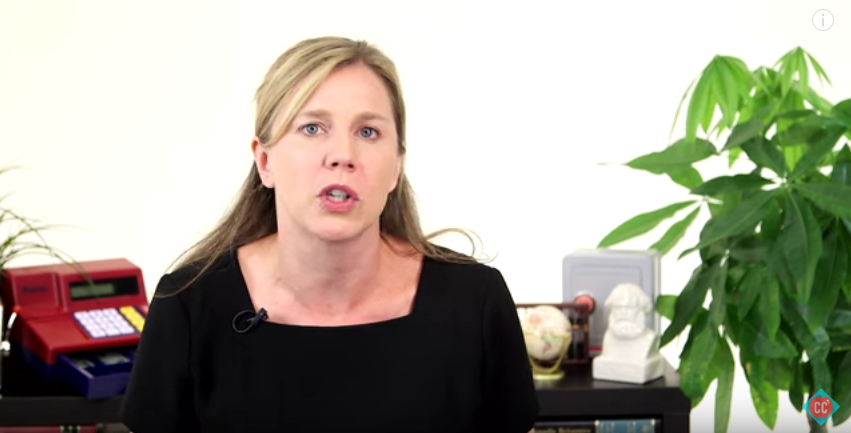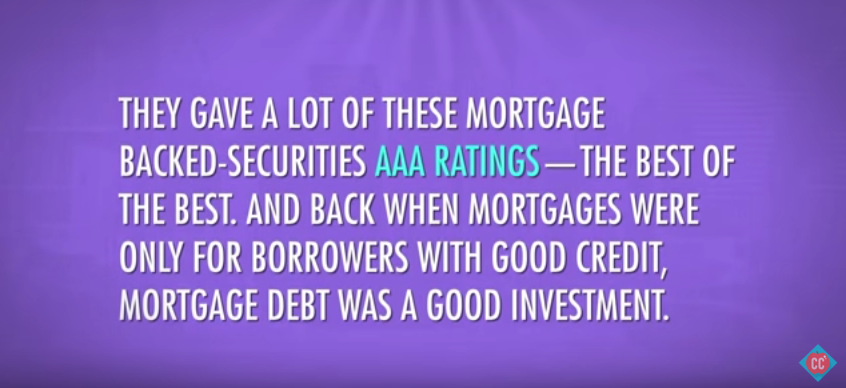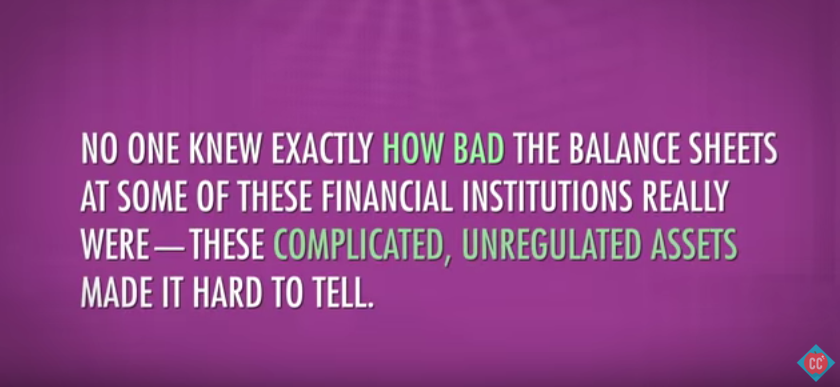Personal Note: It’s been a while since I’ve made a post, and my apologies for that. I currently have a lot on my plate in my non-CCC life (believe it or not, this is not my day job), but I’ve recently received some thoughtful emails concerned with if I have given up or not. In the blogging world (or any project in digital media for that matter) it can be tough to stick with it, but the encouraging messages like the few I’ve received do make a difference, and for that, this project is revitalized and will be as great as ever. And away we go…
This episode is a mammoth. The 2008 financial crisis is one of the most significant moments in US economic history. 600-page books and hours-long debates have dedicated themselves to this topic, and Crash Course bravely tries to sum it all up in about 10 minutes. That’s a tough task for anyone to do.
For the most part, the facts in the Crash Course video are 100% objectively correct. The subjective element, however, comes in with the particular ways the hosts describe the events to imply that something is good or bad. My other main objection to the video comes with what it chooses not to include, despite it being very, very important to what happened.
Mortgages and Lending Practices
It’s very difficult to simply explain what caused the financial crisis without sounding partisan, but I usually explain it this way: banks gave home loans to people who couldn’t pay them back in the future.
This is a good starting point. Now, whether you want to argue that these loans were made because of capitalist greed or government-created incentives is where the partisan stuff starts coming in. But let’s look at how Crash Course explains it:

Investors were pretty desperate to buy more and more and more of these [mortgage-backed] securities so lenders did their best to help create more of them, but to create more of them, they needed more mortgages, so lenders loosened their standards and made loans to people with low income and poor credit. You’ll hear these called subprime mortgages.
Eventually, some institutions even used what are called predatory lending practices to generate mortgages. They made loans without verifying income and offered absurd adjustible-rate mortgages with payments people could afford at first, but it quickly ballooned beyond their means.
If you, as an intelligent Crash Course fan, thought critically about the implications of making bad loans, you would ask youself: Why weren’t lenders worried about not being paid back? Would you, intelligent Crash Course fan, make a loan of $20 to a random person who approached you on the street if he said he would pay you back $40 in a week? You probably wouldn’t, because he probably wouldn’t pay you back and you don’t want to lose $20. So why would enourmous financial institutions in the business of giving mortgages make loans to untrustworthy borrowers? Why would anyone willingly agree to something that will lose them money? We’ll return to this in a bit.
Financial Products from Morgages

After our Crash Course hosts briefly talk about the root of the problem (bad mortgages), they spend several minutes on different new financial products derived from mortgages. These Mortgage-backed Securities include CDOs and Credit Default Swaps. Crash Course’s explanations of these financial instruments are pretty accurate (from my knowledge), so I don’t think many people, regardless of their political persuasion or economic school of thought, would take issue to how they explained these.
Another accurate point by Crash Course is how leveraged these financial institutions were. A lot of these firms were holding a large number of these bad financial products as safe assets, especially since the credit-rating agencies rated them the highest rating (AAA).
Credit Rating Agencies
Crash Course mentioned at the beginning of the video the role that the credit-rating agencies played:

They gave a lot of these mortgage-backed securities AAA ratings–The best of the best. And back when mortgages were only for borrowers with good credit, mortgage debt was a good investment.
So all these new financial products came onto the scene, and the credit-rating agencies were still rating them AAA, giving a guarantee of the high probability of them being paid back. They were, of course, completely wrong on this.

No one knew how bad the balance sheets at some of these financial instutions really were –these complicated, unregulated assets made it hard to tell.
With these two words, Crash Course has diagnosed the problem (assets are too complicated), and has already prescribed the solution (regulation).
The word “unregulated” here is a bit of a misnomer. Since the financial sector is the most regulated industry in the country, and there exists an enormous agency just for securities (the SEC), calling any financial product unregulated would be a stretch. However, there were not any specific regulations on these particular financial products, which seems to be what the issue really is. But since mortgages were heavily regulated and regulators couldn’t stop bad mortgage loans from happening, I doubt any regulation specific to these financial products made before the crash would have done any good.
Crash Course is completely right on their point about how complicated these new securities were. They were very complicated. But who is in charge of verifying the quality of complicated assets? The credit-rating agencies.
Crash Course seems to be giving the credit-rating agencies some slack here, forgiving them for giving good ratings to bad securities because the securities were complicated.
What’s Missing

Crash Course then goes on to talk about the government response to the crisis: bailouts, stimulus, and Dodd-Frank. Other than the similar partisan phrasing as I mentioned previously, most of their telling of history is spot on.
Mr. Clifford then talked about certain principles (Perverse Incentives, Moral Hazard) that created the crisis, and Adriene summed up the Financial Crisis Inquiry Commision’s report, which blamed the regulators (for not doing enough) and too much faith in free markets.
It seems like Crash Course leaves it at that: either it’s the fault of the financial instutitions, regulators not doing enough, or the free markets. Pick who to blame among these three.
It’s astonishing to see no mention of any government action (as opposed to inaction) that is to blame for the crash.
Fannie Mae and Freddie Mac were two Government Sponsored Enterprises (SPE) that purchased many subprime mortgages, as they were directed to hold a large number of assets related to affordable housing. These SPEs contributed significantly to the high demand of subprime mortages and banks issuing these mortgages, since they could be quickly sold to the SPEs for a profit.
The Federal Housing Administration was also missing from the video. The FHA encouraged banks to issue subprime mortgages by guaranteeing their repayment through their FHA insurance policy. If a third party takes away all the risk of giving a loan, then why wouldn’t a bank want to give more loans, even if they are to untrustworthy lenders?
These government actors could have been included under Mr. Clifford’s “Moral Hazard” explanation, but it was nowhere to be found.
Crash Course is correct when they say that the financial crisis is incredibly complicated and caused by many different things; however, a little critical thinking would have you leaving this video with more questions than answers. This post is a brief alternative explanation from Crash Course’s video, but the official Crash Course video left a lot to be explained and the subject deserves multiple explanations.
For a more thorough explanation of the crisis from a free-market perspective, I strongly recommend Tom Woods’ Meltdown.
Thanks for sticking with me, fans of CCC. I’m still 3 episodes behind, but I’ll try to catch back up ASAP.
-Gary